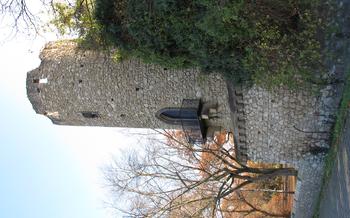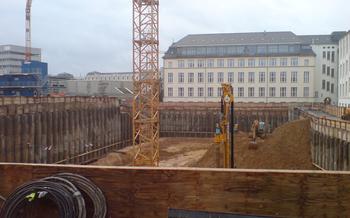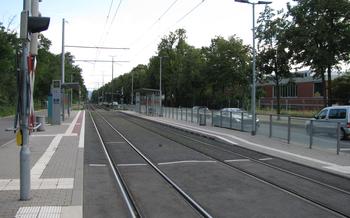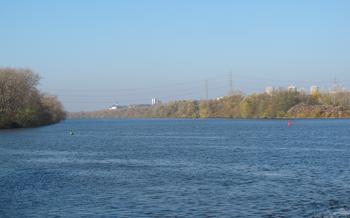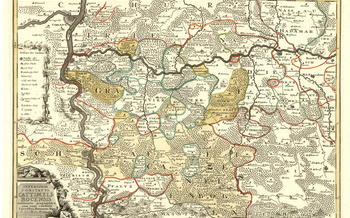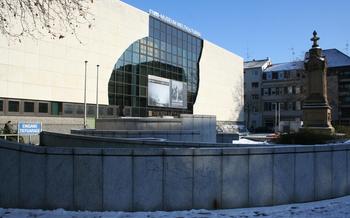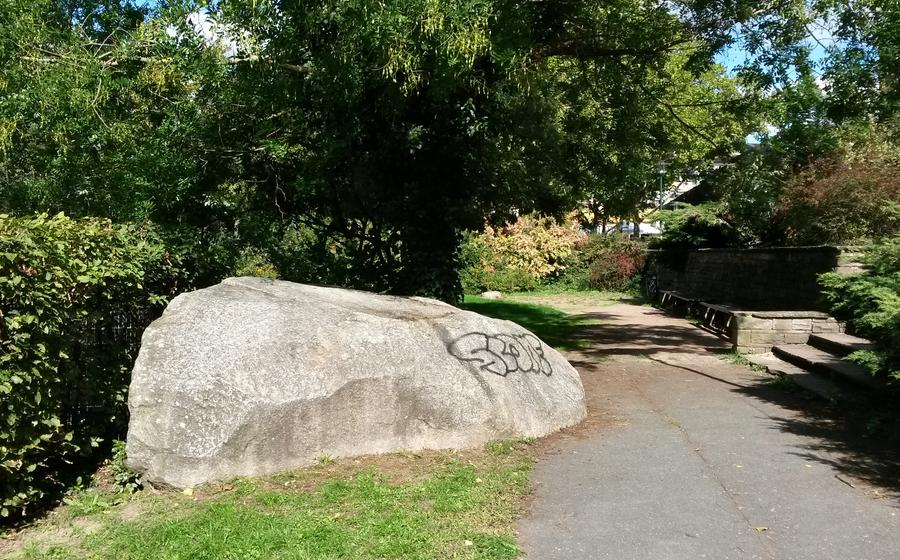
Hinkelstein
- Hinkelstein: A Megalithic Marvel
- Unveiling the Mystery: Archaeological Discoveries
- Theories and Speculations: Purpose and Origins
- Exploring the Megalithic Landscape
- A Journey Through Time: Visiting the Hinkelstein
- Legends and Folklore Surrounding the Hinkelstein
- Insights from Local Experts: Interviews and Perspectives
- The Hinkelstein in Art, Literature, and Popular Culture
- The Hinkelstein in the Context of Megalithic Culture
- Events and Festivals: Celebrating the Hinkelstein's Legacy
- The Hinkelstein in Modern Times: Changing Perceptions
- Educational Programs and Workshops: Unlocking the Past
- The Hinkelstein and Sustainable Tourism
- Insider Tip: Exploring Beyond the Hinkelstein
Hinkelstein: A Megalithic Marvel
In the heart of Germany, nestled amidst the serene landscapes of Darmstadt, lies a captivating megalithic wonder known as the Hinkelstein. This impressive standing stone, shrouded in mystery and intrigue, has stood tall for centuries, captivating the imaginations of historians, archaeologists, and visitors alike. As one of the most significant megalithic monuments in the region, the Hinkelstein holds immense historical, architectural, and cultural significance, inviting us on a journey into the depths of ancient civilizations.
Historical Significance
The Hinkelstein's origins can be traced back to the Neolithic period, a time when humans transitioned from a nomadic lifestyle to settled farming communities. This megalithic monument, estimated to be over 5,000 years old, serves as a testament to the ingenuity and craftsmanship of our ancestors. Its remarkable preservation over millennia speaks volumes about the enduring legacy of prehistoric cultures.
Architectural Features
Standing at an impressive height of over 3 meters, the Hinkelstein exudes an aura of grandeur and mystery. Its massive size and weight, estimated to be several tons, hint at the immense effort and coordination required to erect such a structure without the aid of modern machinery. The stone's rough-hewn surface bears witness to the passage of time, while its imposing presence evokes a sense of awe and wonder in those who behold it.
Cultural Importance
The Hinkelstein holds profound cultural significance, representing a tangible link to our prehistoric past. As one of the few remaining megalithic monuments in the region, it offers a glimpse into the beliefs, rituals, and practices of ancient societies. The stone's enigmatic nature has sparked countless theories and speculations, contributing to its allure and fascination.
Location and Accessibility
Conveniently situated in the municipality of Seeheim-Jugenheim, just a short distance from the vibrant city of Darmstadt, the Hinkelstein is easily accessible to visitors. Its proximity to major transportation hubs and tourist attractions makes it an ideal destination for those seeking to delve into the depths of ancient history while enjoying the modern amenities of a thriving urban center.
Unveiling the Mystery: Archaeological Discoveries
The Hinkelstein has been the subject of extensive archaeological investigations over the years, revealing a wealth of artifacts and insights into ancient rituals. Excavations conducted in the 19th century uncovered numerous stone tools, pottery fragments, and human remains, suggesting the site's use as a burial ground. Further excavations in the 20th century yielded additional artifacts, including jewelry, weapons, and tools, providing glimpses into the daily lives of the people who frequented the site. These discoveries have helped piece together the puzzle of Hinkelstein's purpose and significance, shedding light on the cultural and religious practices of the Neolithic era.
Ongoing research and preservation efforts continue to deepen our understanding of the Hinkelstein. Archaeological teams employ modern techniques such as radiocarbon dating and geophysical surveys to uncover new information about the site's chronology and construction methods. Conservation efforts focus on preserving the integrity of the megalithic structure and its surroundings, ensuring its longevity for future generations. Through these ongoing endeavors, the Hinkelstein continues to yield valuable insights into the lives and beliefs of our ancient ancestors.
Theories and Speculations: Purpose and Origins
The Hinkelstein has been the subject of numerous theories and speculations regarding its purpose and origins. One common theory suggests that it served as an astronomical marker, aligned with the movements of the sun and stars. This hypothesis is supported by the observation that the stone's orientation aligns with the summer solstice sunrise.
Another theory proposes that the Hinkelstein was a burial site, with the large stone serving as a marker or memorial for the deceased. This theory is based on the discovery of human remains and grave goods in the vicinity of the stone.
Some scholars believe that the Hinkelstein may have had a religious or ceremonial significance, serving as a place for rituals or gatherings. This theory is supported by the presence of cup marks and other carvings on the stone, which may have been used for ritual purposes.
Despite the numerous theories, the true purpose of the Hinkelstein remains a mystery. The lack of written records from the time period makes it difficult to definitively determine its function. Ongoing archaeological research and excavations may shed further light on the origins and significance of this enigmatic megalith.
Exploring the Megalithic Landscape
The Hinkelstein is not just an isolated megalith; it is part of a broader megalithic landscape that awaits exploration. Surrounding the site, you will find a variety of other megalithic structures, each with its own unique features and stories to tell.
A short walk from the Hinkelstein, you can visit the Steinkiste von Wetzlar, a burial chamber that dates back to the 4th or 3rd millennium BC. Inside, you can see the remains of human bones and grave goods, offering a glimpse into the burial practices of the region's ancient inhabitants.
Further afield, the Megalithpark Dietzenbach offers a fascinating collection of megalithic monuments, including standing stones, menhirs, and cromlechs. Here, you can explore the diversity of megalithic culture and learn about the different types of structures that were built during this period.
To fully immerse yourself in the region's megalithic heritage, embark on one of the many hiking trails that wind through the surrounding countryside. These trails take you past ancient monuments, offering a chance to admire their impressive size and construction.
Whether you're a seasoned hiker or simply looking for a leisurely stroll, there are trails suitable for all fitness levels. Along the way, you'll encounter stunning natural scenery, from rolling hills to lush forests, making your exploration of the megalithic landscape a truly unforgettable experience.
A Journey Through Time: Visiting the Hinkelstein
Visiting the Hinkelstein is an awe-inspiring and educational experience that transports visitors back in time. For those planning a trip to this enigmatic megalith, here's a practical guide to make the most of your visit:
-
Visiting Hours: The Hinkelstein is generally accessible to the public from dawn to dusk throughout the year. However, it's advisable to check with local authorities or tourist information centers for any seasonal variations or special events that may affect visiting hours.
-
Admission Fees: Admission to the Hinkelstein is free of charge, allowing visitors to explore this ancient monument without any financial barriers. This free access encourages everyone to experience the cultural and historical significance of the site.
-
Guided Tours: Guided tours are available for those who want to delve deeper into the history and mysteries of the Hinkelstein. These tours are led by experienced guides who provide insights into the archaeological discoveries, theories, and cultural significance of the site.
-
Self-Guided Exploration: For those who prefer a more independent experience, self-guided exploration is also an option. Information boards and brochures are available at the site to help visitors navigate and understand the various features of the Hinkelstein.
-
Interactive Exhibits: To enhance the visitor experience, interactive exhibits have been set up near the Hinkelstein. These exhibits provide hands-on activities, multimedia presentations, and augmented reality experiences that bring the ancient world to life.
-
Educational Resources: For those interested in learning more, educational resources such as books, pamphlets, and online articles are available. These resources provide detailed information on the history, archaeology, and cultural significance of the Hinkelstein.
Legends and Folklore Surrounding the Hinkelstein
The Hinkelstein is not only an archaeological wonder but also a source of fascination and inspiration for local myths and folklore. According to one legend, the stone was placed by a giant named Hinko, who used it as a stepping stone to cross the Rhine River. Another tale tells of a magical creature called the Erdmännchen (earth man) who guarded the Hinkelstein and granted wishes to those who approached it with pure intentions.
These legends reflect the deep connection between the Hinkelstein and the cultural heritage of the region. The stone has been a source of fascination and wonder for generations, inspiring stories and traditions that have been passed down through the centuries. The local community takes great pride in these legends, which are seen as a symbol of their cultural identity.
Moreover, the Hinkelstein is believed to possess healing powers. It is said that touching the stone can cure various ailments, especially those related to fertility and childbirth. This belief has led to the practice of pregnant women visiting the Hinkelstein to seek blessings for a safe and successful delivery.
Exploring the legends and folklore surrounding the Hinkelstein offers a glimpse into the rich cultural tapestry of the region. These stories add a layer of enchantment to the site, making it not just a historical monument but also a place of mystery and wonder.
Insights from Local Experts: Interviews and Perspectives
To gain a deeper understanding of the Hinkelstein and its significance, I had the privilege of interviewing local experts, including archaeologists, historians, and cultural enthusiasts. Their insights provided invaluable perspectives on the site's history, cultural importance, and ongoing research.
Archaeologist Dr. Eva Schmidt shared her experiences excavating the Hinkelstein and the fascinating artifacts they uncovered. She emphasized the importance of interdisciplinary collaboration in unraveling the mysteries of the site.
Local historian Herr Klaus Müller spoke about the cultural significance of the Hinkelstein, highlighting its role in local folklore and traditions. He explained how the site has been a source of inspiration for artists, writers, and musicians throughout history.
Cultural enthusiast Frau Anna Weber shared her passion for preserving the Hinkelstein's legacy. She organizes annual events and workshops to engage the community and promote awareness of the site's importance.
These interviews provided unique insights into the Hinkelstein, allowing me to present a comprehensive and nuanced understanding of this remarkable megalithic marvel.
The Hinkelstein in Art, Literature, and Popular Culture
The Hinkelstein's cultural impact extends beyond archaeological significance, inspiring creative works across various mediums. In the realm of art, the megalith has been immortalized in paintings and sculptures, capturing its imposing presence and enigmatic aura. Literature has also embraced the Hinkelstein as a source of inspiration, with authors weaving tales that explore its historical and cultural significance.
The Hinkelstein's influence is not limited to traditional art forms; it has also made its mark in popular culture. References to the megalith can be found in films, television shows, and even video games, where it often serves as a symbol of ancient mystery and wonder. These cultural representations contribute to the Hinkelstein's enduring legacy, ensuring that its story continues to captivate and inspire generations to come.
The Hinkelstein in the Context of Megalithic Culture
The Hinkelstein stands as a testament to the rich megalithic culture that flourished across Europe during the Neolithic and Bronze Ages. While it is a unique and awe-inspiring monument in its own right, it also shares striking similarities with other megalithic sites found throughout the continent.
One of the most notable parallels can be seen in the construction techniques employed at the Hinkelstein. The use of massive stone blocks, carefully fitted together without the use of mortar or other binding agents, is a hallmark of megalithic architecture. This construction style can be observed in other iconic megalithic sites, such as Stonehenge in England, the Carnac Stones in France, and the Newgrange passage tomb in Ireland.
Furthermore, the Hinkelstein's alignment with the astronomical phenomena, particularly the summer solstice sunrise, suggests a shared understanding of celestial events among megalithic cultures. This alignment is mirrored in other megalithic sites, such as the Ring of Brodgar in Scotland and the Maeshowe chambered cairn in Orkney, which were also constructed with astronomical alignments in mind.
These similarities point to a broader cultural exchange and influence that existed among megalithic communities across Europe. The Hinkelstein, therefore, can be viewed as part of a larger network of megalithic monuments, each contributing to a shared cultural heritage that continues to fascinate and inspire to this day.
Events and Festivals: Celebrating the Hinkelstein's Legacy
The Hinkelstein, a testament to the rich cultural heritage of the region, is not merely a monument frozen in time. Throughout the year, a variety of events and festivals are held to commemorate its significance and bring the ancient past to life. These events offer visitors a unique opportunity to delve into the cultural traditions and customs associated with this megalithic marvel.
One of the most popular events is the annual Hinkelstein Festival, held during the summer months. This vibrant festival showcases local music, dance, and culinary delights, creating a festive atmosphere that immerses visitors in the region's cultural heritage. Workshops and demonstrations provide hands-on experiences, allowing participants to learn about traditional crafts and skills.
For those seeking a more immersive experience, guided tours led by local experts offer a deeper understanding of the Hinkelstein's history, significance, and cultural context. These tours provide an opportunity to explore the surrounding landscape and discover other megalithic sites in the region, tracing the footsteps of ancient civilizations.
Cultural performances, exhibitions, and reenactments bring the Hinkelstein's story to life, showcasing the diverse cultural expressions inspired by this megalithic monument. These events provide a platform for local artists, musicians, and storytellers to share their interpretations and perspectives, fostering a sense of cultural exchange and understanding.
Attending events and festivals centered around the Hinkelstein is not only a delightful and entertaining experience but also a meaningful way to connect with the region's cultural heritage and traditions. These events celebrate the enduring legacy of the Hinkelstein, fostering a sense of pride and appreciation among locals and visitors alike.
The Hinkelstein in Modern Times: Changing Perceptions
Over time, attitudes towards the Hinkelstein have undergone a significant transformation. In the past, it was often viewed with a mixture of awe and superstition, seen as a relic of a forgotten era. However, with the advent of archaeological research and the growing understanding of megalithic culture, the Hinkelstein has become a symbol of cultural heritage and a source of pride for the local community.
In modern times, the Hinkelstein is recognized as a valuable historical monument and a testament to the ingenuity of our ancestors. It has become a popular destination for tourists and history enthusiasts, who come to marvel at its imposing presence and learn about its enigmatic past. The Hinkelstein stands as a reminder of the rich cultural heritage of the region and its enduring significance as a symbol of resilience and continuity.
Through educational programs, guided tours, and community initiatives, the Hinkelstein has become a focal point for promoting cultural awareness and appreciation. It serves as a reminder of the importance of preserving and protecting our shared heritage for future generations. The changing perceptions of the Hinkelstein reflect the evolving understanding and appreciation of our cultural roots, highlighting its enduring relevance in the modern world.
Educational Programs and Workshops: Unlocking the Past
The Hinkelstein serves as an educational hub, nurturing a deep understanding and appreciation for the past among visitors of all ages. Educational programs tailor-made for schools and community groups bring the fascinating history of the megalith to life. Interactive workshops and engaging activities delve into the archaeological discoveries, theories, and cultural significance of the site. These immersive experiences foster a sense of wonder and curiosity, encouraging participants to explore and appreciate the rich cultural heritage that surrounds them. Whether it's hands-on artifact handling, simulated excavations, or storytelling sessions, these programs provide a unique opportunity for students and visitors to connect with the past in a meaningful and lasting way.
The Hinkelstein and Sustainable Tourism
The importance of responsible tourism practices cannot be overstated when visiting the Hinkelstein and its surroundings. As travelers, we have a responsibility to minimize our environmental impact and support local communities. By choosing eco-friendly transportation options, reducing waste, and respecting the natural and cultural heritage of the region, we can ensure that the Hinkelstein remains a source of wonder and inspiration for generations to come.
Supporting local businesses and initiatives is another key aspect of sustainable tourism. By patronizing local restaurants, shops, and tour operators, we directly contribute to the economic well-being of the community. This ensures that the benefits of tourism are shared equitably and that local traditions and culture are preserved.
Balancing tourism with the preservation of the Hinkelstein and its surroundings is a delicate task. By adhering to designated trails, avoiding disturbing wildlife, and respecting the privacy of local residents, we can help protect this unique site for future generations.
Remember, sustainable tourism is not just about reducing our impact on the environment; it's about creating a positive and meaningful connection with the place we visit. By embracing responsible practices, we can ensure that our travels are both enjoyable and sustainable, leaving a lasting legacy that respects and celebrates the Hinkelstein's cultural significance.
Insider Tip: Exploring Beyond the Hinkelstein
While the Hinkelstein is undoubtedly a must-see attraction, the surrounding region offers a wealth of other hidden gems and off-the-beaten-path experiences for curious travelers.
A short drive from the Hinkelstein, you can visit the Mathildenhöhe in Darmstadt, a UNESCO World Heritage Site. This beautiful park is home to stunning Art Nouveau architecture, including the Hochzeitsturm (Wedding Tower) and the Russisches Haus (Russian House).
For those interested in exploring the natural beauty of the region, the Odenwald Forest is a great option. This vast forest offers scenic hiking trails, picturesque lakes, and charming villages.
If you're looking for a unique and memorable experience, be sure to visit the Burg Frankenstein, a 13th-century castle perched on a hilltop overlooking the town of Darmstadt. This castle is steeped in history and legend, and it offers stunning views of the surrounding countryside.
To create a well-rounded itinerary, consider spending a few days exploring the Hinkelstein and its surroundings. This will allow you to delve deeper into the region's rich history, culture, and natural beauty.
Here's a suggested itinerary:
Day 1:
- Morning: Visit the Hinkelstein and learn about its fascinating history and cultural significance.
- Afternoon: Explore the Mathildenhöhe in Darmstadt and admire its stunning Art Nouveau architecture.
- Evening: Enjoy a traditional German dinner at a local restaurant.
Day 2:
- Morning: Hike through the Odenwald Forest and discover its hidden gems, such as waterfalls and secluded lakes.
- Afternoon: Visit the Burg Frankenstein and learn about its haunting legends.
- Evening: Attend a cultural performance or event in Darmstadt.
Day 3:
- Morning: Visit the Darmstadt State Museum to learn about the region's history and culture.
- Afternoon: Relax and unwind in one of Darmstadt's many parks or gardens.
- Evening: Enjoy a farewell dinner at a local restaurant and reflect on your memorable journey.
Remember to plan your trip in advance, especially if you're visiting during peak season. Check for any special events or festivals that may be taking place during your visit, as these can add an extra layer of excitement to your trip.
